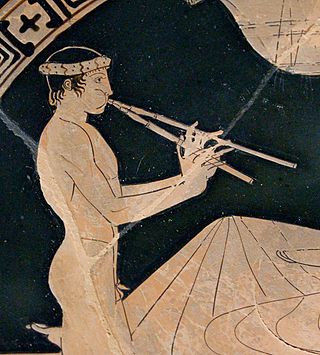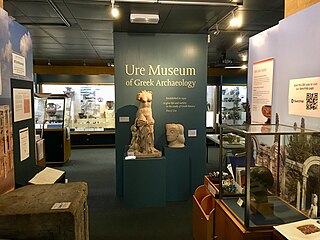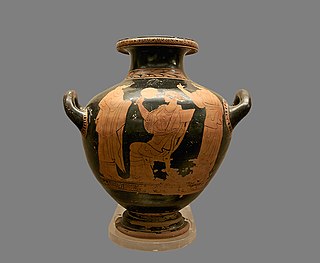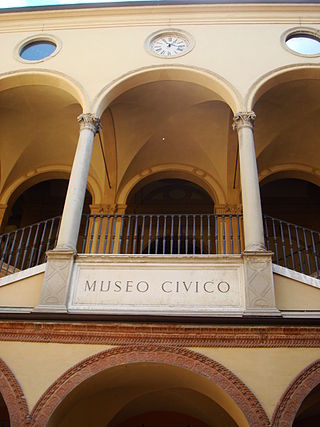
The Reading Aulos is the surviving half of an ancient Greek aulos (reed-blown double pipe). It is much more complete than other examples found to date, and is on permanent display at the Ure Museum of Greek Archaeology in Reading, England.

The Reading Aulos is the surviving half of an ancient Greek aulos (reed-blown double pipe). It is much more complete than other examples found to date, and is on permanent display at the Ure Museum of Greek Archaeology in Reading, England.
The aulos has a length of 38 centimetres [1] and is made of wood clad in bronze with sections decorated in silver. The bell-shaped top, missing the (detachable) reed required for playing, is made from bone or ivory and is covered in silver. [2]
The top half features a prominent pear-shaped bulb which following water-damage has split revealing the make-up of the wooden core and the bronze cladding. Below this section the decoration of one of the silver foil bands can be clearly seen: elaborate ridges and grooves. [2]
The lower half contains most of the holes used for playing the instrument and features further silver foil decoration (atop the bronze cladding); the end terminates in a similar bell-shaped form as the top. [2]
Unlike other auloi, the Reading Aulos's bronze cladding appears to be the method for holding the sections securely together rather than the more common use of spigot-and-socket joints. Due to corrosion the bronze cladding has lost all its original finish. [2]
Since acquisition by the museum restorative work has been performed to correctly align the lower section of the lower half with the rest of the instrument. [2]
The aulos was purchased by the museum from a Sotheby's auction in 1967 for the sum of £100 (with financial aid from The Trustees of the Victoria & Albert Museum). [2] As was also the case with the museum's acquisition of the Etruscan amphora showing Troilos, it was considered an undervalued item – its original clumsy restoration is believed to have been the primary reason for this. [3]
Little if anything is known of its provenance. Dr J G Landels, an expert in ancient music and a member of the University of Reading’s Department of Classics, dated the instrument to no earlier than the 4th century BC, and believed it to be most likely from Asia Minor. [2]
Following purchase, Landels completed a detailed study of the instrument in 1968 and published his findings in The Annual of the British School at Athens .
The Reading Aulos, as it later became known, is a prominent item in the museum’s collection, and is on permanent display, freely available to view by the public. In 2018 it was selected, along with other items from the Ure and the British Museum, to be a central feature of the major exhibition ‘Music and Materiality’ held at the museum.

Bronze is an alloy consisting primarily of copper, commonly with about 12–12.5% tin and often with the addition of other metals and sometimes non-metals, such as phosphorus, or metalloids such as arsenic or silicon. These additions produce a range of alloys that may be harder than copper alone, or have other useful properties, such as strength, ductility, or machinability.

The British Museum is a public museum dedicated to human history, art and culture located in the Bloomsbury area of London. Its permanent collection of eight million works is among the largest and most comprehensive in existence. It documents the story of human culture from its beginnings to the present. The British Museum was the first public national museum to cover all fields of knowledge.

A torc, also spelled torq or torque, is a large rigid or stiff gentlemen's neck ring in metal, made either as a single piece or from strands twisted together. The great majority are open at the front, although some have hook and ring closures and a few have mortice and tenon locking catches to close them. Many seem designed for near-permanent wear and would have been difficult to remove. Torcs have been found in Scythian, Illyrian, Thracian, Celtic, and other cultures of the European Iron Age from around the 8th century BC to the 3rd century AD. For Iron Age Celts, the gold torc seems to have been a key object. It identified the wearer as a person of high rank, and many of the finest works of ancient Celtic art are torcs. Celtic torcs disappeared in the Migration Period, but during the Viking Age torc-style metal necklaces, mainly in silver, came back into fashion. Similar neck-rings are also part of the jewellery styles of various other cultures and periods.

A rhyton is a roughly conical container from which fluids were intended to be drunk or to be poured in some ceremony such as libation, or merely at table. A rhyton is typically formed in the shape of an animal's head. Items were produced over large areas of ancient Eurasia, especially from Persia to the Balkans. Many have an opening at the bottom through which the liquid fell; others did not, and were merely used as drinking cups, with the characteristic that they could not usually be set down on a surface without spilling their contents.

An aulos or tibia (Latin) was an ancient Greek wind instrument, depicted often in art and also attested by archaeology.

Niello is a black mixture, usually of sulphur, copper, silver, and lead, used as an inlay on engraved or etched metal, especially silver. It is added as a powder or paste, then fired until it melts or at least softens, and flows or is pushed into the engraved lines in the metal. It hardens and blackens when cool, and the niello on the flat surface is polished off to show the filled lines in black, contrasting with the polished metal around it. It may also be used with other metalworking techniques to cover larger areas, as seen in the sky in the diptych illustrated here. The metal where niello is to be placed is often roughened to provide a key. In many cases, especially in objects that have been buried underground, where the niello is now lost, the roughened surface indicates that it was once there.

The Ure Museum of Greek Archaeology is a museum of ancient Mediterranean archaeology, primarily that of ancient Greek civilisation but with smaller collections of Egyptian, Etruscan and Roman items. It contains one of the most important collections of ancient Greek pottery in the United Kingdom. The museum is part of the University of Reading's University Museums and Special Collections Services (UMASCS), and is located in and works closely with the university's Department of Classics. The museum is situated on the university's Whiteknights Campus, about 2 miles (3.2 km) from the centre of the English town of Reading, Berkshire. The museum is open to the public and entry is free.

The Delphic Hymns are two musical compositions from Ancient Greece, which survive in substantial fragments. They were long regarded as being dated circa 138 BC and 128 BC, respectively, but recent scholarship has shown it likely they were both written for performance at the Athenian Pythaides in 128 BC. If indeed it dates from ten years before the second, the First Delphic Hymn is the earliest unambiguous surviving example of notated music from anywhere in the western world whose composer is known by name. Inscriptions indicate that the First Delphic Hymn was written by Athenaeus, son of Athenaeus, while Limenius is credited the Second Delphic Hymn's composer.

The hydria is a form of Greek pottery from between the late Geometric period and the Hellenistic period. The etymology of the word hydria was first noted when it was stamped on a hydria itself, its direct translation meaning 'jug'.

The Borghese Vase is a monumental bell-shaped krater sculpted in Athens from Pentelic marble in the second half of the 1st century BC as a garden ornament for the Roman market; it is now in the Louvre Museum.

Music was almost universally present in ancient Greek society, from marriages, funerals, and religious ceremonies to theatre, folk music, and the ballad-like reciting of epic poetry. It thus played an integral role in the lives of ancient Greeks. There are some fragments of actual Greek musical notation, many literary references, depictions on ceramics and relevant archaeological remains, such that some things can be known—or reasonably surmised—about what the music sounded like, the general role of music in society, the economics of music, the importance of a professional caste of musicians, etc.

The music of ancient Rome was a part of Roman culture from the earliest of times. Songs (carmen) were an integral part of almost every social occasion. The Secular Ode of Horace, for instance, was commissioned by Augustus and performed by a mixed children's choir at the Secular Games in 17 BC. Music was customary at funerals, and the tibia, a woodwind instrument, was played at sacrifices to ward off ill influences. Under the influence of ancient Greek theory, music was thought to reflect the orderliness of the cosmos, and was associated particularly with mathematics and knowledge.

A salpinx was a trumpet-like instrument of the ancient Greeks.
Percy Neville Ure M.A. was the University of Reading's first Professor of Classics (1911–1946) and the founder of the Ure Museum of Greek Archaeology at Reading. His wife and former pupil at Reading, Annie Ure (1893–1976), was the museum's first Curator from 1922 until her death. The Ures were experts on Greek and Egyptian antiquities, and particularly Greek ceramics. With Ronald M. Burrows, they undertook important excavations at Rhitsona in Boeotia, Greece.

The Archaeological Civic Museum of Bologna is located in the fifteenth-century Palazzo Galvani building at Via dell'Archiginnasio 2 postal code 40124 Bologna, once known as the Hospital of Death. Founded in September 1881 by the merging of two separate museums: the one belonging to the University of Bologna – heir of the Room of Antiquity belonging to the Academy of Sciences founded by Luigi Ferdinando Marsili in (1714) – and that belonging to the City of Bologna (enriched by the antique collection of Artist Pelagio Palagi and the large amount of finds from excavations conducted in and around Bologna during these times.

Ancient Greek art stands out among that of other ancient cultures for its development of naturalistic but idealized depictions of the human body, in which largely nude male figures were generally the focus of innovation. The rate of stylistic development between about 750 and 300 BC was remarkable by ancient standards, and in surviving works is best seen in sculpture. There were important innovations in painting, which have to be essentially reconstructed due to the lack of original survivals of quality, other than the distinct field of painted pottery.

Mechanical music technology is the use of any device, mechanism, machine or tool by a musician or composer to make or perform music; to compose, notate, play back or record songs or pieces; or to analyze or edit music. The earliest known applications of technology to music was prehistoric peoples' use of a tool to hand-drill holes in bones to make simple flutes. Ancient Egyptians developed stringed instruments, such as harps, lyres and lutes, which required making thin strings and some type of peg system for adjusting the pitch of the strings. Ancient Egyptians also used wind instruments such as double clarinets and percussion instruments such as cymbals. In Ancient Greece, instruments included the double-reed aulos and the lyre. Numerous instruments are referred to in the Bible, including the horn, pipe, lyre, harp, and bagpipe. During Biblical times, the cornet, flute, horn, organ, pipe, and trumpet were also used. During the Middle Ages, hand-written music notation was developed to write down the notes of religious Plainchant melodies; this notation enabled the Catholic church to disseminate the same chant melodies across its entire empire.
The Ure Museum’s ancient Egyptian funerary boat is a 12th Dynasty, Middle Kingdom model boat; believed to have been manufactured between 1991–1786 BC. It was discovered during excavations in the group of tombs described as the ‘Tombs of the Officials’ at Beni Hasan, Egypt.

The Ure Museum’s Etruscan amphora showing Troilos is a mid to late 6th century black-figure terracotta amphora of the ‘Pontic’ type attributed to the Tityos Painter. The main decoration is a depiction of the ambush of the Trojan Troilos by the Greek hero Achilles.

The psalterion is a stringed, plucked instrument, an ancient Greek harp. Psalterion was a general word for harps in the latter part of the 4th century B.C. It meant "plucking instrument."